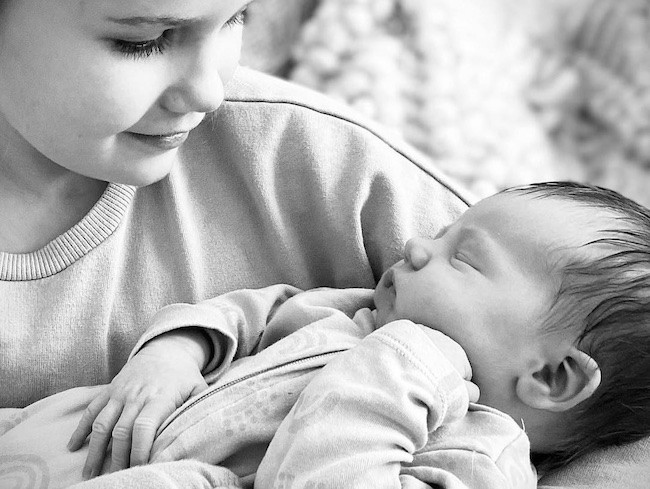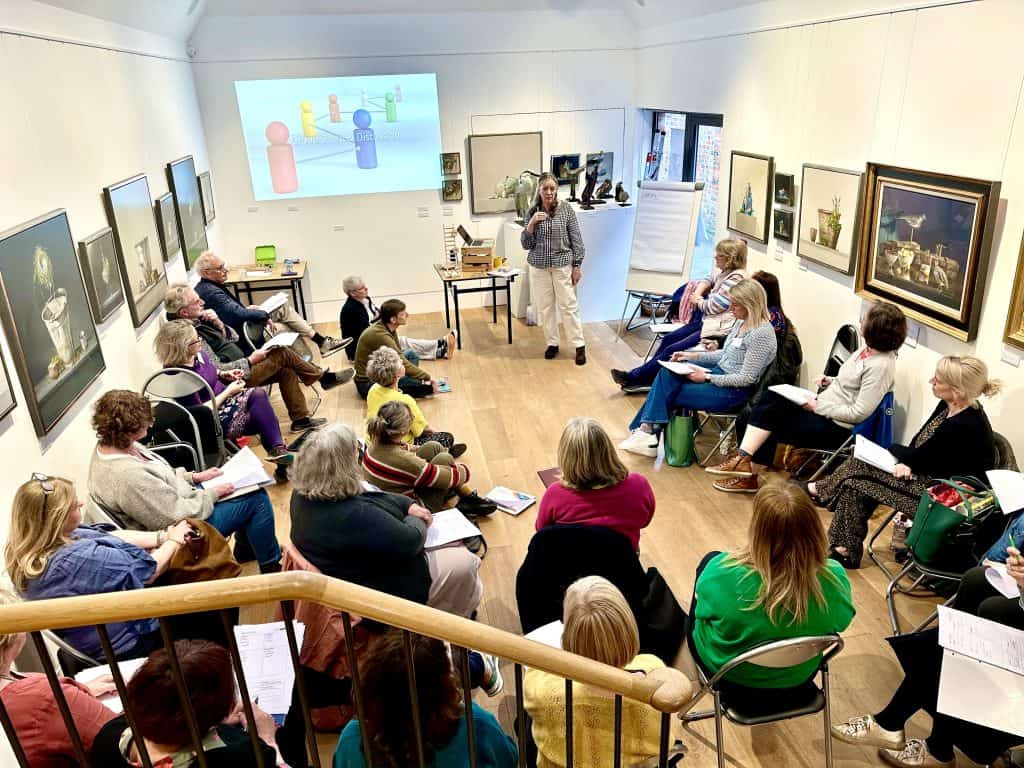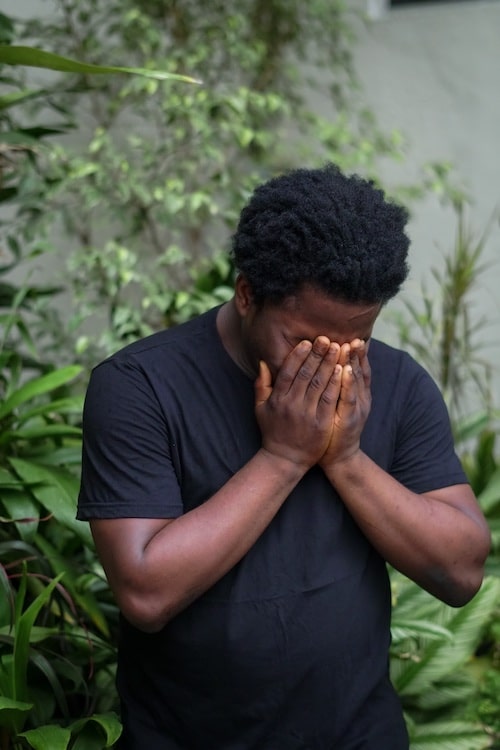We enjoyed an interesting and thought provoking in-person seminar with our host, Briony Martin. The…

Polyvagal Theory and Internal Family Systems, Integrating Polyvagal Theory (PVT) and Internal Family Systems (IFS) into your clinical practice and life (April 2023)

Twenty six therapists gathered in person at the lovely Art Gallery at the White Horse Bookshop in Marlborough for a day’s learning on the subjects of Polyvagal Theory (PVT) and Internal Family Systems (IFS). The energy and liveliness of the group was palpable, perhaps due to the joy of coming together, face to face, for the first time in a long time.
Liz Calvert Thompson, a certified IFS therapist and a founding member of IFS UK, facilitated the day, introducing us to the conceptual frameworks of both models and how they fit together. She interspersed theory with several experiential exercises which brought the theories alive and helped us understand them from the ‘inside out’. Liz was keen to point out that PVT only applies clinically to neurotypical individuals, therefore the theory does need refinement.
The autonomic nervous system is made up of two main branches: the sympathetic and the parasympathetic. In the Parasympathetic branch Polyvagal Theory focusses on two pathways travelling within a nerve called vagus. Vagus meaning ‘wanderer’, it travels from the brain stem and then travels in two directions downwards through the lungs, heart, diaphragm and stomach, and upward to connect with nerves in the neck throat, eyes and ears. The vagus divides into two parts: the ventral vagal and the dorsal vagal.
A) Ventral Vagal. This responds to cues of safety and supports social connection. It is in ventral and Self energy (IFS) that we can feel emotionally regulated. Porges calls it the Compassion Nerve (one of the 8 C’s of IFS ) and is the agent of healing (if we want to work with clients to bring about healing and fire up new neural pathways it is from ventral vagal or Self energy in IFS that this can happen).
B) Sympathetic branch is found in the middle part of the spinal cord and is responsible for sensing cues of danger and the release of adrenalin which causes and enables mobilisation and the flight and fight response.
C) Dorsal vagal pathways respond to cues of extreme danger. It takes us out of connection, out of awareness, shuts us down and makes us feel heavy, immobilised, exhausted and withdrawn. The origins of dorsal lie in our ancient vertebrate ancestors and is the most primitive in the hierarchy built into our Autonomic nervous system.
To progress from dorsal shut down into ventral vagus safety and connection, we HAVE to go through the sympathetic nervous system (often with small physical movements), hence there is a hierarchy of ladder.
IFS’s central tenet is the multiplicity of mind: that we are all made of discreet ‘parts’ or ‘sub-personalities’. The focus is not on fixing or eliminating parts but to understand what has happened in the client’s life, thereby understanding the roles these parts have had to play, and to help parts cooperate with each other. It is a non-pathologising model, eg you are not an alcoholic, but you have an alcoholic part which has a hidden positive intention.
In IFS our system is understood to be organised into three main areas:
- Self – experienced as open-heartedness, compassion, calm, confidence, clarity, curiosity, courage, connectedness, creativity and is the agent of healing and change. It is the one who witnesses and can talk for our parts.
- Protectors which are either i) Managers – concerned with the future and often socially-sanctioned and rational parts eg hard-working parts, or ii) Firefighters which are reactive, impulsive and sometimes extreme eg addictions, suicidality, dissociation.
- Exiles which are usually childhood wounds or trauma that have not been processed or integrated, eg a part that feels unlovable or not-good-enough.
These parts live in the landscape of our nervous system, thereby there is a correlation with PVT as listed above.
There are three ways of experiencing our parts within the IFS framework:
- physical sensations (eg temperature, tension),
- bodily expression (eg blushing, speech, posture) and
- energetic expression (eg pressure, weight).
The organising principles of PVT are:
- neuroception – detecting what is happening without awareness, inside our body, in the world around us and in connection with others
- hierarchy: ventral vagus (heart space), sympathetic nervous system (SNS – fight/flight) and dorsal (stuck trauma). It is not possible to move from a dorsal state (shut down) into a ventral state without going through the physical mobilisation of the sympathetic nervous system.
- co-regulation – this is required if we are to shift ‘up the PVT ladder’ from dorsal, through the SNS and into ventral. Co-regulation is achieved through compassion rather than empathy. The client’s distress needs to be met by the therapist without fear, thereby providing containment. It is important that the therapist remains in ‘Self energy’ to avoid becoming burdened or disregulated by too much empathy.
Delegates were invited to take part in a number of experiential exercises, one of which was called the Fire Drill. We experienced what happens to a client if the therapist becomes, for instance, distracted or impatient. The client can immediately feel disregulated, withdrawn or distressed. Additionally, we listened to three different types of music and were asked to notice how these each stimulated different parts of the vagus nerve and IFS parts, in our feelings, thoughts, behaviour, bodily responses, our experience of the world and our sleep patterns.
Techniques used for helping a person regulate (move from dorsal through SNS to ventral) include breathing, meditation, small physical movements (yawning, shaking, standing up, wiggle toes, move to a different chair), therapeutic touch (if you have a touch agreement), slowing down/pausing, music, singing and remembering/repeating/noticing moments of connection and play -especially when relating these to bodily sensations.
Liz Calvert Thompson led the training day with grace, humility and humour, fully engaging with participants and answering questions. Her expert facilitation is reflected in the delegates’ positive feedback.I would like to take this opportunity to thank Liz for her teaching skills and all delegates for their generous participation and openness.
_______________________________________________________________________________________________
Average feedback scores from our event:
Organisation of event: 4.7 out of 5
Speaker: 4.9 out of 5
_______________________________________________________________________________________________
Feedback from our event:
“Well placed / regular breaks helped keep focus. Very knowledgeable and informed speaker”
“The natural flow and organic way in which the subject was delivered was very relatable / experiential and informative” – Luisa Miller, University of Bristol
“Clear, creative, experiential, what a fab day”
“I found the embodiment of the principles by the speaker/presenter as she was presenting particularly helpful”
“I particulary found the experiential parts of the workshop helpful”




This Post Has 0 Comments